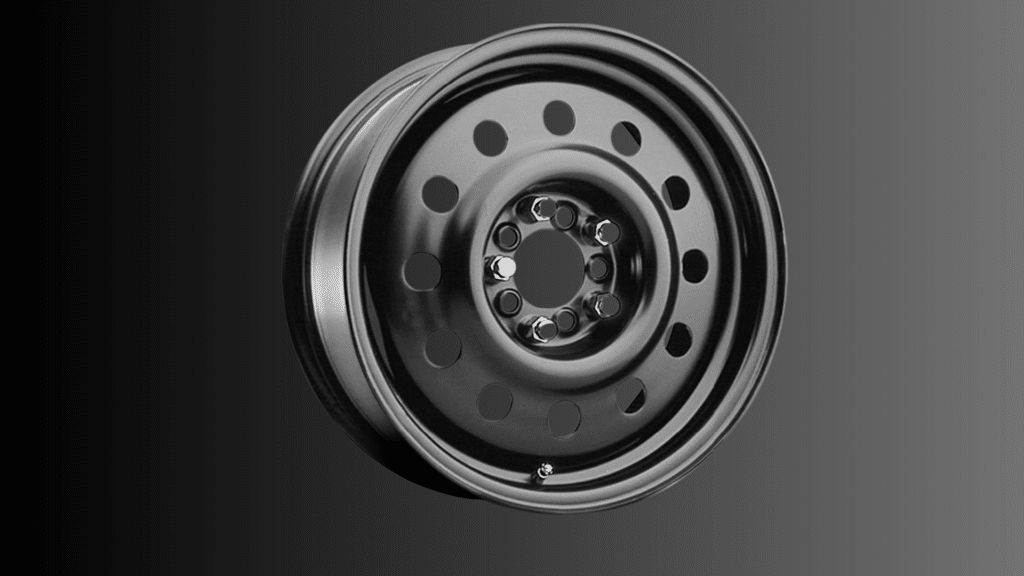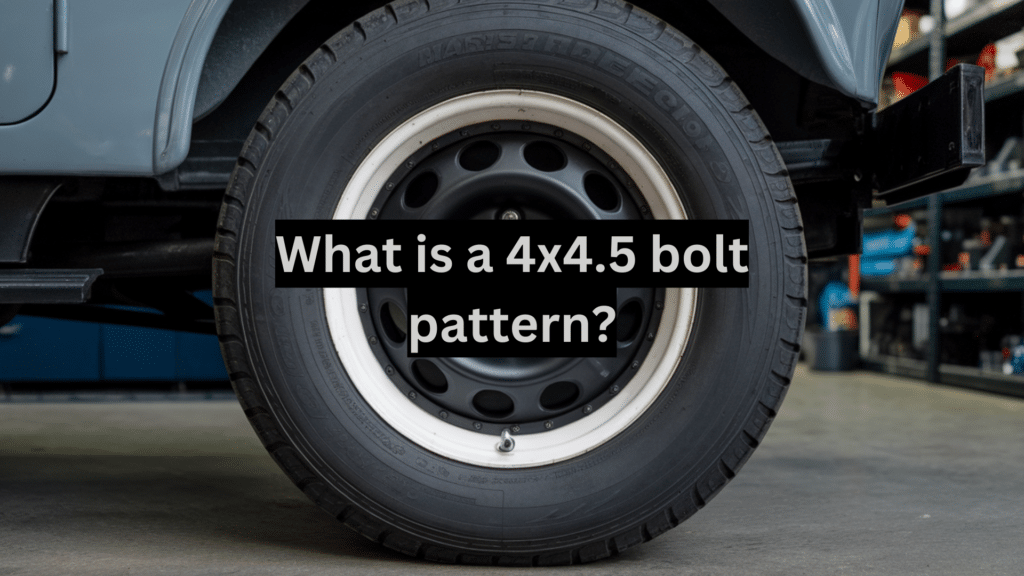Have you ever looked at your vehicle’s wheels and wondered about those mysterious bolt patterns? You’re in the right place if you’re trying to figure out what a 4×4.5 bolt pattern means.
In this article, I’ll explain everything you need to know about the 4×4.5 bolt pattern (also called 4×114.3mm) – what it means, which vehicles use it, and how to measure it correctly.
Whether you’re shopping for new wheels, replacing a damaged rim, or just curious about your vehicle’s specifications, understanding bolt patterns is essential.
By the end of this guide, you can confidently identify if your car has a 4×4.5 bolt pattern.
I’ve worked with wheels and tires for over 15 years, helping thousands of vehicle owners find the right fit. No more confusion or expensive mistakes when buying new wheels!
What is a 4×4.5 Bolt Pattern?

A 4×4.5 bolt pattern tells you two important things about your wheel:
- The “4” means your wheel has four lug holes
- The “4.5” shows the diameter of the circle these holes make (measured in inches)
Think of it like this: If you drew a circle connecting all the lug holes on your wheel, that circle would be 4.5 inches across.
Sometimes, you’ll see this written as 4×114.3mm instead. Don’t worry – it’s the same thing! Car folks just converted the 4.5 inches to millimeters.
I know these numbers might seem confusing at first. Let me break it down:
The bolt pattern is crucial when buying new wheels. If you get this wrong, your new wheels simply won’t fit your vehicle.
Have you ever seen a wheel with 5 or 6 holes instead of 4? Those vehicles have different bolt patterns, like 5×4.5 or 6×5.5.
Your 4×4.5 pattern is fairly common and used on many popular vehicles including Honda Civics, Nissan Sentras, and several Mazda models.
Understanding this measurement means you can shop for wheels with confidence!
Common Vehicles with a 4×4.5 Bolt Pattern
Many popular vehicles use the 4×4.5 (or 4×114.3mm) bolt pattern. Here’s a list of common makes and models you might recognize:
Honda
- Civic (1984-2000)
- Accord (1976-1989)
- Del Sol
- Prelude (1979-1991)
Nissan/Datsun
- Sentra (1982-2012)
- 200SX
- 240SX (1989-1994)
- Altima (1993-2001)
- NX1600/NX2000
Mazda
- Mazda3 (select years)
- Miata/MX-5 (1990-2005)
- RX-7 (1979-1985)
- Protegé
Mitsubishi
- Eclipse (1990-1999)
- Lancer (certain models)
- Mirage
Other Makes
- Acura Integra (1986-2001)
- Hyundai Accent (many years)
- Kia Spectra
- Lexus IS250 (select models)
- Subaru Legacy/Impreza (early models)
If you drive one of these vehicles, you likely have a 4×4.5 bolt pattern.
Remember that manufacturers sometimes change bolt patterns between generations of the same model, so double-check your year before purchasing new wheels.
Need to verify your vehicle’s bolt pattern? I’ll show you how to measure it in the next section.
Benefits of Using the 4×4.5 Bolt Pattern
The 4×4.5 bolt pattern offers several practical advantages for vehicle owners. Here’s why this specific configuration can be beneficial:
Wide Availability of Wheels
- Finding replacement wheels is usually easier with this pattern
- More aftermarket options at various price points
- It is common enough that even salvage yards often have compatible wheels
Cost Effectiveness
- Higher production volumes typically mean lower prices
- Used wheels are plentiful and generally affordable
- Less expensive than rare or exotic bolt patterns
Lightweight Design
- 4-lug wheels are typically lighter than five or 6-lug wheels
- Less unsprung weight can improve handling and acceleration
- It may contribute to slightly better fuel economy
Versatility
- It fits a wide range of vehicles from different manufacturers
- One set of wheels might work across multiple vehicles you own
- Allows for easier wheel swapping between compatible cars
Proven Reliability
- Used successfully for decades on millions of vehicles
- More than strong enough for most daily driving situations
- Simple design with fewer components that could potentially fail
For most passenger cars and light crossovers, the 4×4.5 bolt pattern provides the perfect balance of strength, weight, and practicality.
This is why so many manufacturers have chosen it for their mainstream vehicles.
Considerations When Selecting Wheels
When shopping for wheels with a 4×4.5 bolt pattern, there are several important factors to keep in mind beyond just the bolt pattern itself:
Wheel Offset
- Determines how far your wheels sit in or out from your vehicle
- Wrong offset can cause rubbing against fenders or suspension components
- Usually measured in millimeters (positive, zero, or negative)
- Your vehicle’s factory offset is typically the safest choice
Center Bore Size
- The hole in the middle of the wheel must be large enough to fit your hub
- Hub-centric wheels fit perfectly on your hub for better balance
- Wheel spacers or hub-centric rings may be needed for non-exact fits
Load Rating
- Each wheel has a maximum weight capacity
- Must be appropriate for your vehicle’s weight and use
- Undersized wheels can crack or fail under heavy loads
Wheel Size & Tire Compatibility
- Larger-diameter wheels require lower-profile tires
- Width affects handling, traction, and tire options
- Dramatic size changes may require suspension modifications
Material & Construction
- Alloy wheels are lighter but more expensive
- Steel wheels are heavier but more durable for off-road use
- Cast vs. forged construction affects strength and weight
Clearance Issues
- Brake calipers need adequate space
- Suspension components must not contact the wheel
- Winter conditions may require room for chains
I recommend consulting your vehicle’s manual or a professional wheel installer before significantly changing your factory wheel specifications.
The right wheels enhance performance and appearance, but the wrong ones can create safety hazards and expensive problems.
Maintenance and Troubleshooting
Proper maintenance of wheels with a 4×4.5 bolt pattern helps ensure safety and longevity. Here are some practical tips and solutions for common issues:
Regular Inspection
- Check for cracks, bends, or other damage every few months
- Look for corrosion around lug holes that might weaken the wheel
- Inspect for uneven tire wear, which may indicate alignment problems
Proper Torquing
- Always use a torque wrench when installing wheels
- Tighten lug nuts in a star pattern (never circle)
- Follow your vehicle’s specific torque specifications (usually 80-100 ft-lbs)
- Re-check torque after driving 50-100 miles with new wheels
Common Problems and Solutions
Vibration While Driving
- It could be wheel balance issues – get tires rebalanced
- Bent wheel – inspect and replace if necessary
- Lug nuts may have loosened – check and retorque
Rust Around Lug Holes
- Clean with a wire brush and apply a rust converter
- Use anti-seize compound on studs (not threads) when reinstalling
- Consider upgrading to stainless lug nuts
Difficulty Removing Wheels
- Spray penetrating oil on stuck lug nuts
- Never use an impact gun to install lug nuts (hand tools only)
- Consider replacing rusted wheel studs
Remember that your wheels are critical safety components. If you notice any unusual vibrations, sounds, or handling issues, have your wheels inspected by a professional immediately.
Conclusion
Understanding the 4×4.5 bolt pattern gives you valuable knowledge for maintaining and upgrading your vehicle’s wheels.
This common bolt pattern offers excellent versatility, affordability, and performance for many popular cars.
Whether replacing a damaged wheel, upgrading to a new style, or just trying to understand your vehicle better, knowing these specifications helps you make informed decisions.
Consider factors like offset, center bore, and load rating alongside the bolt pattern when selecting new wheels.
With proper maintenance and careful selection, your wheels will provide thousands of miles of safe, reliable service.
The next time you look at your vehicle’s wheels, you’ll recognize exactly what those numbers mean and why they matter.
Frequently Asked Questions
Can I Use Wheels with a 4x100mm Bolt Pattern on a Vehicle with a 4×4.5 (4×114.3mm) Bolt Pattern?
No, these patterns are not interchangeable. The 14.3mm difference means the wheels would not align properly with your wheel studs. Never use wheels with A different bolt pattern than what your vehicle requires.
How Do I Measure My Bolt Pattern if I’m Not Sure It’s 4×4.5?
Measure from the center of one lug hole to the center of the lug hole directly across from it. if this distance is 4.5 inches (or 114.3mm), you have a 4×4.5 bolt pattern. For 4-lug wheels, you can also measure from center to center of adjacent lug holes.
Will All 4×4.5 Wheels Fit Any Vehicle with a 4×4.5 Bolt Pattern?
No. while the bolt pattern might match, other factors like offset, center bore size, and wheel dimensions must also be compatible with your specific vehicle model.
Can I Convert My Vehicle from a 4×4.5 Bolt Pattern to A Different Pattern?
Yes, but it typically requires replacing hubs, rotors, and possibly other suspension components. This conversion is complex and usually expensive, so it’s rarely worth doing unless for specialized applications.
are 4-Lug Wheels Strong Enough for Heavier Vehicles or Towing?
For vehicles designed with A 4×4.5 bolt pattern, 4 lugs provide adequate strength for their intended use. however, they’re generally not suitable for heavy towing or extreme off-road use, which is why trucks and su vs. typically use 5, 6, or 8-lug patterns instead.


